As I have mentioned elsewhere when I built and dedicated this site to 213 Squadron I always intended it to cover all the staff and not just Aircrew. Understandable the records I worked from were written about the Squadron History which was written accounts of aircraft, losses deployment and pilots so its always nice when one of the Ground crew take time to write about their experiences in the Squadron.My sincere thanks to Neil Cairnes for his contribution.
Neil posted on the message board
I served on 213 Squadron from 1967 until it folded, at RAF Bruggen, RAFG. I attended the handing in of the colours at St Celent Danes in London. I was a Junior Technician aircraft engine fitter on the Canberras
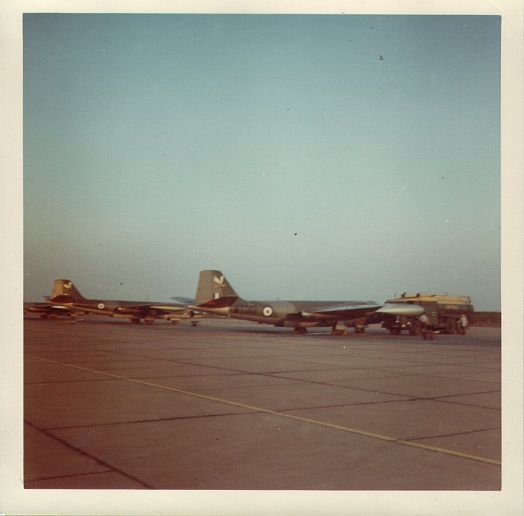
213 Squadron 1968
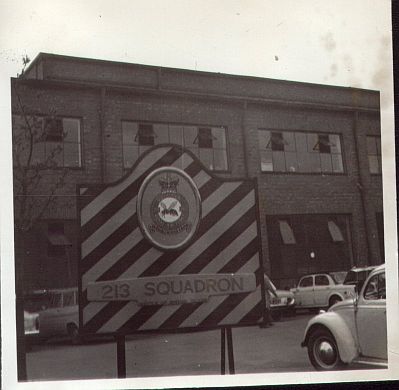
.My first posting after training in 1966 was to RAF Wittering, where I worked on the Blue Steel missile as fitted to the Victor. Even today this confuses people as many think this nuclear stand-off bomb was only ever carried by the Vulcan. Arriving as a lowly LAC Aircraft Engine Mechanic, I was busied off to Trade Training every Wednesday afternoon by my section Warrant Officer, WO Mann, to study for promotion. I soon gained my Senior Aircraftsman badge, and continued to be one of the very few to pass my 'Fitters' exam as a 'Direct Entry', becoming a J/T, a Junior Technician. But the Victor was about to be removed from the Cold War Front Line, and many of us were soon posted. I was posted to RAFG, 213 Squadron. I had received my posting when a SAC, but arrived as a shiny, new J/T! I flew from Luton airport on BEA, who delivered me to RAF Wieldenwrath and my luggage to RAF Gutterslough. So I spent the first three days at Bruggen in civvies, the SWO refusing to see me until I could attend in uniform to 'arrive'. Accommodation for the 'single' squadron ground crews was in a single-storey barrack block with eighteen men to each room. We shared this block with 80 Squadron who had the other half.
213 Squadron shared a hangar with 80 Squadron, both flew the Canberra but 213 had Bomber-Interdictors (BI) and 80 were a photographic/reconnaissance (PR) unit. Oddly, 213 had the only Canberra BI6 versions in the whole RAF. It seems once 213 had been fitted out with them, the other three squadrons who were to get the BI6 instead had the updated BI8 version. The ground crew had a crew room on the ground floor of the hangar, the aircrew upstairs had a much better set of rooms. Wing Commander Chandler was the CO, and I first met him when I was sent out to see his aircraft off. He placed his glasses on the step just inside the cockpit entrance door, did his walk round, then upon getting into the kite, trod on his glasses! I have forgotten the name of the Flight Lieutenant Engineering Officer who was my immediate boss, but he did seem to be stressed up nearly all the time I remember. The only airmen's names I can remember are SAC Neil Cuzins, engines; SAC Steve O'Hara, engines; Sid, Fezz and Tony who were all riggers, and chief Tech Brookes who was an Avionics Tech ( known as fairies). My job on the unit was as a first-line 'sooty' (because we got covered in soot when we went up jet-pipes to inspect turbines) which entailed carrying out 'before-flight' (b/f)) and 'after-flight' (a/f) servicing, curing minor snags, minor engine snags, assisting ASF (Aircraft Servicing Flight, centralised engineering support was already creeping into the RAF) in engine and fuel tank changes. The a/f included refueling the aircraft.
213 Squadron Hanger
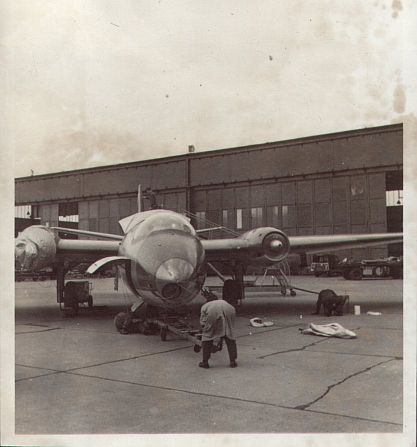
Our version of the Canberra (and there are many) had tip-tanks, wing tanks and a central fuselage tank. We used ancient AEC and Magirus bowsers where we 'over-wing' refueled. That is, one had a long hose with a nozzel on the end and undid fuel caps. One would start on one wing-tip-tank, then the wing tank on that side which had the kite sinking down on that side's oleo main leg. Then the central tank was filled, followed by the other side's wing tank. By now the 'full' side of the kite would be right down on its oleo-leg, and the last tip-tank way up in the air. One would sit astride this last tank, right out on the wingtip and high up. As the tank filled, that side oleo leg would suddenly sink and settle. This brought the tip-tank (a long way out from the leg) down about a foot or more very quickly. If you were not ready for it, you were left a foot above the tank for a second, with Avtur (military aircraft kerosine) blasting out of the open nozzel which had come out of its filler hole! I did once have a hose burst on me whilst filling a central tank, and the fuel was coming out from the bowser at such a pressure, the whole Canberra disappeared into a mist of fuel in seconds. We 'sooties' often had fuel-burns from the 'HiTec' additive in it for lubricity of the Avon's swash-plate fuel pumps.
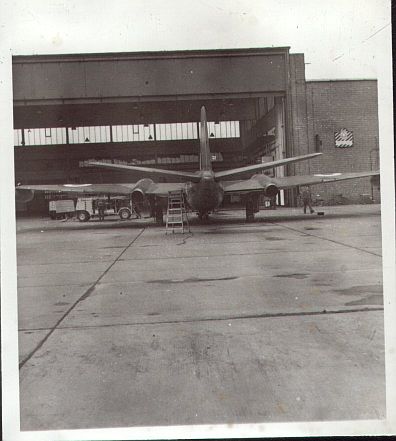
The BI6 had two RR Avon 100 engines fitted. 80 Squadrons PR9's had Avon 200 which were a lot more powerful. Our kites had central bubble cock-pit perspex, 80's had offset 'fighter' perspex, so as well as the different tail motto's you could quickly see which squadron an arriving kite was from. We also had an ancient T4 (a trainer) with really old RR Avon Mk1 engines. Whilst the BI6 Avon 100 had three starter cartridges fitted to each engine, the T4 only had one. So if it failed to start you had to have a spare ready near at hand. For landing away from base they all carried spare cartridges in the rear hatch, as well as a set of engine, oil and control covers. The T4 was sometimes used to make up the flight numbers but it was a slow old bus, and if Roermond (in Holland nearby) was not 200 feet below Bruggen we doubted it would have been 200feet up! RAF Bruggen is right on the German/Dutch border. Most of us went into Roermond for our off duty entertainment.
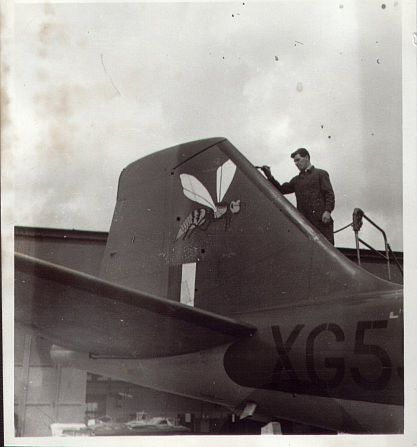
Canberra Servicing.
Canberra Towing
213 sqn fin leading edge repair (bird strike).
We often had 'exercises' where the American bomb would be loaded onto our kites, controlled by big USAF Policemen, who had no sense of humour at all. We would 'Goon Bait' them by walking towards the aircraft we were to service, in a straight line from the line hut. During exercises one should pass through the control area and have your ID checked. Our actions often brought forth the lifting of a revolver from a holster and a shouted warning. As soon as you saw their hand go for the gun, you altered course. No amount of trying to convince them that the shortest route was in a straight line would work.We often had 'exercises' where the American bomb would be loaded onto our kites, controlled by big USAF Policemen, who had no sense of humour at all. We would 'Goon Bait' them by walking towards the aircraft we were to service, in a straight line from the line hut. During exercises one should pass through the control area and have your ID checked. Our actions often brought forth the lifting of a revolver from a holster and a shouted warning. As soon as you saw their hand go for the gun, you altered course. No amount of trying to convince them that the shortest route was in a straight line would work.
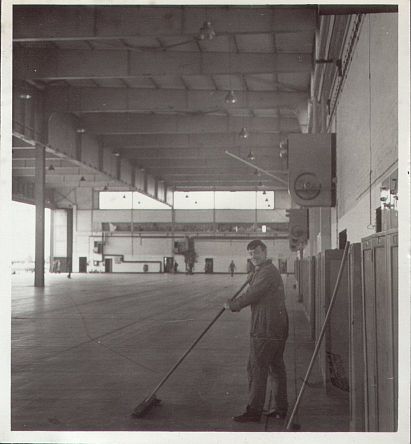
Not all glamour Neil Sweeps the hangar
Two aircraft were kept bombed-up, 24 hours a day, 7 days a week. This was the 'Quick Readiness Alert', known as QRA. We would all spend a seven-day duty on QRA with all meals provided by a cook in a secure compound near the runway end, out in the woods. Bruggen is surrounded by pine forests. A very new navigator arrived one duty, and our Cpl had a quiet chat with the pilot of one of the kites, the aircrew were billeted next door to we erks. Every morning at 10am both aircraft were serviced, they were set up to be airborne in under four minutes. To check out the avionics, a little petrol/electric generator with a Ford Popular side-valve engine was started up and plugged into the kite. One morning it 'refused' to start. So we gained the attention of the new navigator, getting him to assist us to 'bump-start' it. It was a while before it dawned on him that the wheels of this thing were in no way connected to the little engine....by then all the aircrew were hanging out of their accommodation windows cheering him on. Even the huge USAF Policeman and the RAF Snow Drop were laughing. (A military police officer of each service sat opposite each other, each side of the revetment, guarding the machine and real bomb fitted to it.).
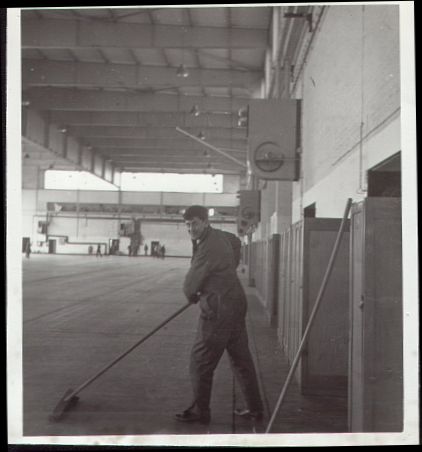
SAC O'Hara mans the broom.
Sadly during my tour a 213 Canberra flew into the side of a Victor over a bombing range in northern Scotland. All were killed. Off duty time was spent in the Malcolm Club singing squadron songs and one very memorable trip to Amsterdam and around their harbour in a boat. I eventually purchased a car, a 1961 LHD Vauxhall Victor. My pay had risen from £7 a week as a SAC, to £9 as a J/T then to £11 a week with RAFG overseas allowance; and we got cigarette and petrol coupons.
During my time with 213 I was detached to Berlin, to find myself selling 'pomfrits mit mayonaise' to Germans on their open day, in my best blue uniform. I thought it would be a 'jolly', no one told us we had to work. Never volunteer I thought. And sadly I was one of the ground crew to attend the final handing in of the colours at St Clement Danes in London. I did not do a full tour because the Squadron folded up, so I had not owned the Victor long enough to avoid import taxes. I sold it to a Maltese SAC who had arrived to work on the Phantoms that were replacing us. We all got a choice of posting. I asked for Lyneham of Abingdon, and got St Mawgan on Shackletons.If you cannot take a joke you should not have joined up. I left Bruggen in late 1969.
Neil Cairns.
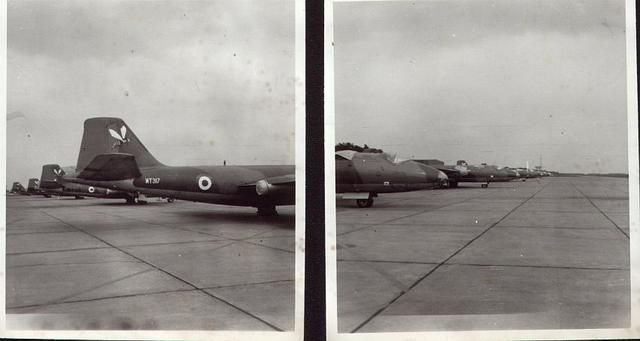
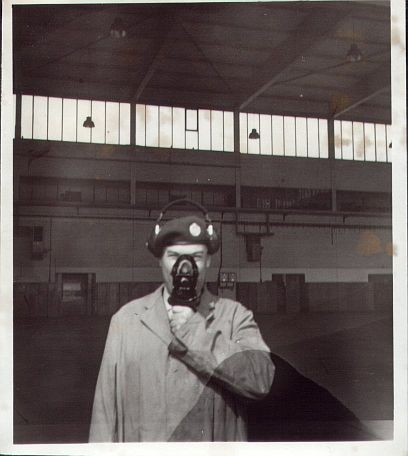
An 'ERK' on 213 Squadron.
C.Tech Brookes (fairy).